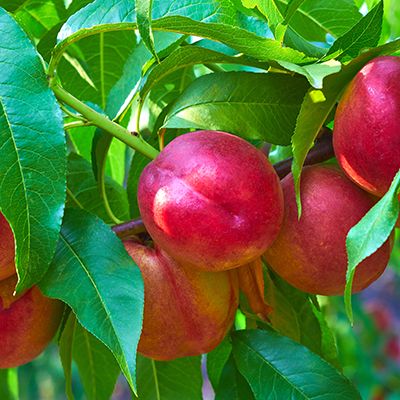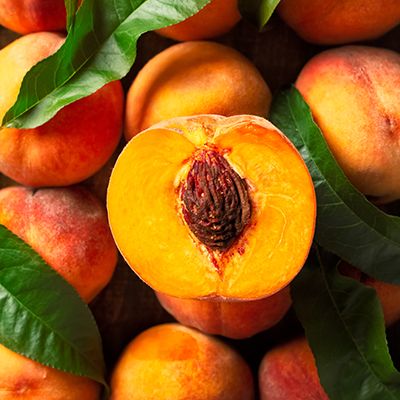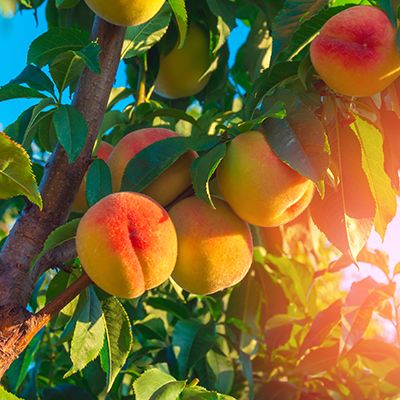


Peach and Nectarine Trees
Prune
When completely dormant in December or January, remove at least half of the long "whips" of current year’s growth on mature trees. Do not remove short secondary branches of current year’s growth. Next year’s fruit will grow on this year’s growth. To identify fruiting wood, see our Fruit Tree Pruning Care Guide.
Spray
Apply three dormant sprays at the end of November, December and January. To make the dormant spray, use 8 tbs of Master Nursery Pest-Fighter Year-Round Spray Oil mixed with 2 tbs Liqui-Cop in one gallon of water. Copper products must contain at least 30% copper. The last spraying must be before any color shows in the flower buds. Liqui-Cop is made more effective by applying it mixed with horticultural oil. The chemical spray Chlorothalonil (Bonide Fung-onil) at the rate of 1 tsp per gallon of water is effective in controlling peach leaf curl. Spray at the same schedule as for Liqui-Cop and read all directions and warnings. None of the organic fungicides have proved effective.
Always check with your Nursery Professional to properly diagnose problems before undertaking additional sprays.
Peach Leaf Curl
Spray: Control is best achieved by applying three dormant sprays as described above, the most important of which is January’s. Research shows that growing season measures, such as picking off infected leaves, blasting leaves with water or spraying with kelp or other nostrums yield no results.
Brown Rot or Blossom Blight – (different names for the same disease) Brown Rot is the most common and serious blossom and fruit disease of stone fruits. The first symptom is the browning and wilting of blossoms which may cling to the twigs for a long time. Cankers (sunken brown areas often develop at the base of the infected flowers. Sticky amber colored gum oozes from the base of the flowers or from the cankers. Prune and remove all diseased parts. The dormant season spray of Horticultural oil and Liqui- Cop should control the disease.
Bacterial canker, or bacterial gummosis, or bacterial blast (different names for the same disease) is common and deadly and caused by Pseudomonas syringae. During the fall, winter and spring, the thin bark of young trees may appear nearly black and a clear, resinous gum exudes from cankers. In older trees, gumming may exude from many areas of the bark and extend up into the small branches often killing them. Splashing rain spreads the bacteria to dormant buds, twigs and branches. Infected blossoms turn brown and wilt; some leaf and flower buds may die. Other branches may fail to produce foliage and later die. The best treatment is to spray the entire tree with Liqui-Cop with 4 tbs per gallon of water while it is dormant. Otherwise, removal of infected wood and flowers is the only treatment.
- Sanitation: Remove and destroy infected buds and blossoms during bloom. Remove and destroy maturing fruit when symptoms appear. In August or September, remove and destroy mummies and fallen fruit. Do not compost.
- Planting the Tree: Ideally, peach trees prefer a soil which drains well. Allow at least 10 feet between the new tree and any other tree or building or wall. In the heavy clay soil of the Peninsula, prepare a large hole and amend the soil as outlined in the Care Guides; Planting Bare Root Trees or Planting Trees and Shrubs. Then plant as described. These care guides can be found on our web site or here at the nursery.
- Fruit Thinning: See section below on Fruit Thinning. Thinning fruit reduces spread of brown rot spores among fruits.
- Irrigation Methods: Use basin or drip irrigation to avoid wetting blossoms, foliage and fruit (see below).
Fertilize
Use Master Nursery Fruit Tree & Vine Food twice a year, around Memorial Day and Labor Day. If you prefer organic fertilizers, use Gardner & Bloome Citrus & Fruit Tree Fertilizer two to three weeks earlier. Water all fertilizers in immediately after application. Supplement organic fertilizers with Green All Iron Sulfate to prevent chlorosis.
Water
At planting, construct a soil berm at the drip line of the tree. As the tree matures, extend the berm to the span of the drip line. Flood weekly during the first year and then at 2 to 4 week intervals when the tree is mature. If a drip system is used, place hosing along the tree’s drip line with emitters on 12 to 16 inch centers. This system will also need to be adjusted as the drip line expands. Keep in mind that a large, mature tree may consume up to 30 gallons of water per week in July, August and September.
Fruit Thinning
Thin fruit when it reaches 1 inch in diameter. Leave one fruit every 6 to 8 inches of shoot growth. Thinning is especially helpful if the tree is affected by brown rot.
Other Comments
Watch for oozing of amber-colored gum on twigs, branches or trunk, which may indicate the presence of borers or fungus. Bring several leaf and twig samples to Wegman’s Nursery for evaluation whenever these or other symptoms appear.
Peach Tree Borers: Look for small piles of reddish brown frass at the base of the tree trunk. Find the hole from which the frass emerged and kill the borer by inserting a stiff wire to crush the larvae. Spray the trunk with Sevin in mid to late May and again in mid-July to kill emerging adults.
Paint trunks and lower branches of young or non-vigorous trees with a one to one mixture of white interior latex paint and water to prevent sunburn injury and reduce borer infestations.Apply the paint mixture from 2 inches below the soil surface to 1 foot above the lowermost scaffold branches.
Adapted from Ogawa and English (1991), Diseases of Temperate Zone Tree Fruit & Nut Crops, UC Extension Publication 3345; and from Flint (1998), Pests of the Garden and Small Farm, 2nd Edition, UC Extension Publication 3332.